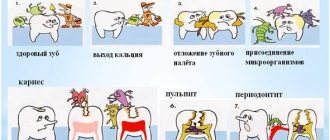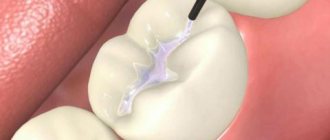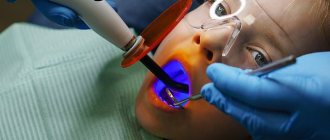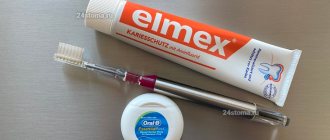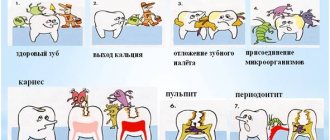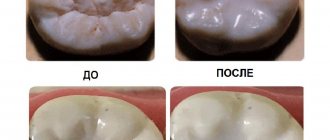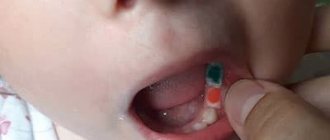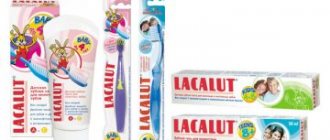Fluoridation of teeth in children is a way to strengthen enamel with the help of an element necessary for the proper development of a growing organism - fluoride. Of course, adults need fluoride no less, however, in childhood, health needs very close attention. This is explained by the rapid development of the child, in particular, the dental system. An unbalanced diet (the presence in the diet of an increased amount of carbohydrates and acids, coloring foods and drinks) and the consumption of too cold or hot water and food can weaken the enamel. Consequences: development of caries and increased sensitivity of teeth.
To prevent caries and strengthen enamel, dentists recommend fluoridation to young patients.
Fluoride is one of many components that participate in the formation of teeth starting from childhood. Together with calcium, this mineral provides strength and integrity. However, due to various factors, such as general health, nutrition, genetics, the baby’s body experiences a fluoride deficiency. The consequence is increased tooth sensitivity and the risk of developing caries.
It is very important for parents to understand that fluoridation is not a method of treating caries, but its prevention. The procedure allows you to protect baby teeth from premature destruction and protects the rudiments of future indigenous and surrounding tissues from the spread of possible carious infection.
An argument against fluoridation is an excess of the mineral in the child’s body. A disease such as fluorosis, as well as problems with the thyroid gland, occur precisely because of the oversaturation of the body with fluoride. An experienced pediatric specialist will not allow an unnecessary procedure to be prescribed.
Why is dental fluoridation important for children in St. Petersburg?
The relevance of the coating procedure with a fluorine-containing substance is explained by the fact that the current environmental situation leaves much to be desired. It is not always possible to find truly natural food products with optimal content of nutrients, in particular fluoride. Fluoridation at an early age (for medical reasons) will help avoid problems with teeth during the period of growing up and the formation of the dental system. Fluoride-containing preparations will saturate your teeth with fluoride in the required amount and keep them healthy.
Is it possible to use varnish at home?
It is allowed to carry out a strengthening procedure at home, but you should still consult a doctor first. Difficulties will arise already at the stage of purchasing varnish - you won’t be able to find a high-quality and safe solution on the open market. It must be ordered from a dental center or specialized medical store.
If you do find a drug and the dentist allows you to use it yourself, do not forget about the rules:
- pre-dry your teeth using cotton swabs;
- apply the product in a very thin layer;
- The varnish should dry naturally for about 5 minutes;
- Do not eat anything for twelve hours after the procedure.
Indications
The enamel of baby teeth does not contain enough minerals to withstand the aggressive effects of microbes. The required amount of minerals accumulates after a couple of years. During this time, teeth require mineral replenishment from the outside, which is fluoridation. Without appropriate preventive measures, there is a risk of developing caries.
Note that this is useful not only for young patients, but also for teenagers, who need it no less. The reasons are as follows: active growth, hormonal changes and other processes of adolescence.
Since the enamel of permanent teeth in young children remains very sensitive for a long time, and the susceptibility to caries is many times higher than in adults, one of the methods of disease prevention is coating with a fluoride-containing substance - fluoride varnish.
Fluoridation of a child's teeth allows you to saturate them with the necessary amount of fluoride and maintain a healthy smile for many years.
Orthodontic treatment of a child is also indicated. Installing braces is fraught with mechanical damage to tooth enamel and the development of caries. To avoid such troubles, the orthodontist may recommend treating the surface of the child’s teeth with fluoride varnish before installing metal plates.
How to replace silvering of teeth?
Not all parents want to undergo this procedure. Are there any analogues if no other treatment is currently possible?
Remineralization therapy for caries
The goal of therapy is to saturate the affected areas with calcium. There are special gels that you can use to treat your teeth at the dentist or at home yourself. The procedure will only have an effect if the teeth are kept clean. If plaque or stone is present, there is no point in holding the event.
Remineralizing therapy is carried out:
- at the initial stage of caries;
- to prevent the formation of carious lesions.
There is nothing particularly complicated in this process, but it is better to consult a dentist, who, before applying the gel, will brush your teeth with a special brush with a paste applied to it, as a result of which the penetration of calcium into the dental tissue will increase. In addition, the doctor can use more concentrated drugs, which will benefit the child.
Therapeutic measures are carried out until the chalky spots disappear, which is individual in each case under consideration, so it is not possible to talk about the duration of the course.
The remineralizing gel, available in different fruit flavors, contains a substance that normalizes acidity and calcium glycerophosphate.
In addition to the gel, it is recommended to use a paste with amino fluoride, which will allow more calcium to be fixed in the enamel.
If caries affects dentin, then such therapy is useless. With average caries, the child is recommended to have either a filling or silvering.
Fluoridation
The procedure saturates the enamel with fluoride, which reduces calcium leaching. Deep fluoridation is justified even for superficial caries, when the white spot stage has already passed, since fluoride, penetrating into the enamel, destroys microorganisms that cause caries.
The higher the fluorine concentration used, the more effective the fluoridation procedure becomes. According to statistics, enamel strengthening occurs in more than 80% of patients who have undergone this operation.
Fluoridation is indicated:
- with white spots on the enamel;
- for caries that does not extend beyond the boundaries of the enamel;
- to prevent the occurrence of new carious lesions.
Fluoridation is a procedure that should only be performed by a qualified physician due to the very high dosages of this substance.
Based on the above, the following conclusions can be drawn:
- For white spots on teeth, it is recommended to carry out remineralization therapy, which in combination with fluoridation will have the most beneficial effect. Silvering is not contraindicated, although it will only be a temporary measure.
- For caries located within the enamel, deep fluoridation is indicated. Silver plating is allowed.
- For moderate caries, the best option would be dental filling. You can do silver plating, which will delay pulpitis, but there is a risk of burning the pulp.
Methods
Superficial fluoridation of teeth in children
The process involves applying a special gel to their surface. This method is used provided that the child’s teeth are healthy. It is most often prescribed to children with baby teeth. It is recommended to carry out the procedure once every six months along with professional oral hygiene.
Deep fluoridation of teeth in children
Recommended after completion of caries treatment. Before directly applying fluoride varnish, the little patient is hygienically cleaned of soft plaque and tartar, then treated with a substance containing fluoride, calcium and magnesium. The effect of deep fluoridation lasts longer than superficial fluoridation due to the deep penetration of strengthening minerals.
Advantages of fluoridation compared to silver plating
Previously, silver plating was used as a preventative measure. But most leading dental clinics abandoned it in favor of deep fluoridation. Here are the reasons:
|
Dentists speak flatteringly about the deep fluoridation procedure. In an interview with the newspaper “Arguments and Facts”, maxillofacial surgeon David Grigoryan Fr.
You can carry out deep fluoridation at our Nikadent clinic in Mytishchi. The cost of the service is quite affordable - about 2.5 thousand rubles. This price includes: professional consultation, preparation, cleaning of tartar, drying of teeth, application of fluoride.
Stages
- Cleaning the surface of teeth from soft plaque and tartar;
- Drying – the surface of the teeth must be dried as much as possible for high-quality fluoride varnish coating;
- Applying a composition with fluorides, magnesium and copper salts using a special brush or a sterile cotton ball;
- Repeated drying for 5-7 minutes naturally;
- Treatment with a composition containing calcium hydroxide.
The formed durable film on tooth enamel, consisting of fluoride ions, is resistant to drinks, food, hygiene procedures, does not fade or deteriorate over time.
How is the procedure done?
Deep fluoridation
It is carried out only in a dental office using special preparations.
The procedure requires minimal preparation. It can be divided into five quick stages
:
- Teeth cleaning. Usually a special paste is used to prepare for fluoridation. But if the child has heavy plaque, another cleaning method is chosen.
- Drying the surface of the teeth.
- “Sealing” the enamel. The doctor applies a drug based on magnesium and calcium (fluorides).
- Second drying of the surface of the teeth.
- Application of the final preparation. Dental clinics use a solution of copper and calcium hydroxide.
| After the procedure, both applied layers react. All components gradually penetrate deep into the tooth, significantly enhancing its mineral structure. An important advantage of deep fluoridation is durability. Components applied to the surface are not washed out and are not affected by food or water. |
Expert opinion of RAIDEN specialists
The fluoridation procedure is useful for the teeth of young patients, subject to indications for its implementation and taking into account contraindications. Fluoride is certainly useful for the formation of a growing organism. Its deficiency during the formation of the dental system can affect not only the health of the teeth, but also the entire body as a whole. Excess is also harmful. Therefore, the correct dosage of fluoride varnish during the procedure is an important point. Fluoridation “within reasonable limits” is a means of avoiding more complex, expensive and painful treatment. It is better to prevent any disease than to treat it. Prices for dental fluoridation depend on the amount of work.
Content:
- Fluoride varnish
- Why use a fluoride-based protectant?
- Contraindications to the use of fluorine-containing varnishes
- Is it possible to use varnish at home?
- Carrying out the procedure in a dental clinic
- Important nuances
Enamel is the hardest tissue of the human body, but even it becomes thinner over time under the influence of a huge number of different factors.
The procedure of protective coating of teeth with a special varnish allows you to protect the outer shell of the unit and make it more durable. In addition, dental compounds used to treat the teeth of children and adults are a kind of antiseptics. They block the spread of pathogens and thus provide reliable caries prevention.
Most often, when providing a protective coating for teeth, dentists use fluoride varnish. This is a special viscous liquid, including fluorine and other related compounds.
Carrying out the procedure in a dental clinic
Dental treatment in a dental clinic is much more effective than at home.
Before proceeding with the manipulation, the doctor carefully cleans the dental crowns from hard stone and soft plaque. Due to this, the fluoridated gel adheres better to the enamel and penetrates into its deeper layers. Afterwards, the work area is isolated from saliva. This is very important and a person is not able to do this on his own. The dentist then uses fluoride varnish. He carefully distributes it over all surfaces, making sure that not a single area is left untouched. Until the solution dries, the person sits with his mouth open.
An experienced dentist knows exactly how much varnish to use and how to apply it correctly. Therefore, the patient does not risk anything. He can be confident in the effectiveness of the therapy.
Why is it necessary?
Fluoridation has obvious benefits that have made it a primary treatment for tooth decay prevention.
This procedure can solve the following problems:
- reduces the likelihood of developing caries by 65%;
- increases enamel hardness;
- improves the structure of hard tissues;
- increases the service life of fillings;
- sensitivity decreases;
- improves the condition of the gums and mucous membranes in the mouth;
- reduces the rate of reproduction of pathogenic microorganisms.
The procedure has distinct advantages compared to others.
These include:
- low price;
- painlessness;
- safety.
These properties make it widespread in modern dental practice. This procedure is carried out from two years of age.
What to do with a child’s lost baby tooth
Many moms and dads willingly follow the Tooth Fairy tradition. Before going to bed, the baby puts the lost tooth under the pillow, and in the morning he finds a gift in its place. This approach also has practical significance: it helps the child overcome the fear of a lost tooth, because in return he receives pleasant compensation.
If you decide to take action in this direction, tell your son or daughter that the healthier the tooth, the better the gift - this is the attitude of the tooth fairy! Why not unobtrusively motivate the heir to maintain oral hygiene?
If you prefer a traditional approach and are used to following beliefs, you can “give the tooth to the mouse,” bury it in the ground or throw it into the fire. Popular beliefs and signs agree: you shouldn’t keep them, much less make amulets out of them! What if the tooth inadvertently falls into the hands of a witch who performs a magical ritual and harms the child? In the modern interpretation, a witch can be any ill-wisher who can “put the evil eye” on a child.
How effective is the fluoridation procedure?
Fluoridation can begin at 1.5–2 years of age. It is necessary to determine why the child needs dental fluoridation. It is important to realize that such a procedure is a preventive measure that can be used, for example, in the initial stages of caries development or in case of increased tooth sensitivity. In addition, fluoridation can be carried out when the fluoride content in drinking water is less than the norm.
Fluoridation does not replace the treatment of caries; the most effective treatment is complete treatment, in which fillings are installed. Fluoridation is a preventive measure and an adjunct to treatment.
What is enamel fluoridation
This is a procedure for saturating the enamel layer with fluoride ions and other minerals. The density of the enamel increases. It protects teeth from the effects of acids and the proliferation of microorganisms in the oral cavity. The procedure is safe and painless.
The essence of the procedure
Due to the low content of calcium and fluoride in the enamel, tooth tissue (dentin and enamel) is destroyed. As a result, they are damaged by bacteria that cause caries. Due to the opening of the dentinal tubules, sensitivity to hot and cold, sweet and sour increases. The purpose of the application is to apply remineralizing compounds to the enamel. As a result of fluoridation, microcrystals of this element are embedded in the dentin tubules and close them. This reduces tooth sensitivity and prevents caries. The procedure can not only prevent the development of the disease, but also slow it down if tissue damage has begun. Fluoride coating prevents caries from spreading in the mouth.
What are dental fissures
There are fissures on both baby teeth and permanent teeth.
These are physiological folds - grooves, dimples and depressions - on the chewing surface of molars and premolars. The incisors and canines do not have fissures. Such cavities easily and quickly fill with plaque, are poorly cleaned with toothpaste and a brush - they become a common cause of carious lesions. Pediatric dentists often suggest sealing fissures - creating a thin film on the surface of the crown that will protect against pathogenic microflora and mechanical damage.
There are two main reasons for fissure sealing:
- Children's inability to take good care of their teeth. Even the most responsible child is not able to clean all the cavities on the surface of molars and premolars, which leads to the development of caries and the need for treatment. Especially if the grooves differ in depth and tortuosity.
- Thin enamel of teeth - milk and permanent during the period of change of bite. The thickness of the enamel of temporary units is half that of permanent ones, which explains its rapid destruction and susceptibility to caries. During eruption, molars are especially vulnerable - initially the crowns are covered with thin, slightly mineralized enamel, and only after 2-3 years the surface becomes resistant to external damage.
Rodikova Tatyana
Before recommending invasive fissure sealing to a patient, I always look at the initial level of mineralization. With a high mineral content and wide grooves, sealing cavities can be easily done without sealing, but there are cases (low mineralization, prone to caries) when sealing the teeth is the best option!
Invasive sealing technique:
Indications for invasive fissure sealing:
- In the presence of narrow deep fissures in teeth with weak enamel mineralization (if the bottom and walls of the fissures cannot be subjected to visual or instrumental control). In this case, it becomes impossible to guarantee the absence of foci of carious lesions in the area of the bottom and walls of the fissures. In addition, in the presence of deep narrow fissures, it is extremely difficult to achieve good filling of the fissure with filling material.
- Initial fissure caries.
- The presence of pigmented fissures in teeth with weak enamel mineralization (with good enamel mineralization, pigmented fissures do not require mandatory invasive sealing).
Expansion of fissures with a drill during invasive sealing –
Unlike non-invasive techniques, invasive fissure sealing involves expanding the fissures with a drill. In Fig. 11 you can see a section of a tooth, which schematically shows how the fissure is expanded with the help of a bur (within the thickness of the enamel). In Fig. 12 you can see that the deep narrow fissures were expanded using a drill (they are indicated by arrows), after which they were filled with composite material (Fig. 13).
Video of fissure treatment with a drill –
At what age is fluoridation allowed?
Remineralization of teeth is allowed from the age of two. The first procedure can be performed immediately after the first baby teeth have erupted. The second critical period for tooth enamel is adolescence. During this period, hormonal changes occur in the body, affecting the functioning of all organs and systems.
There is a change in the composition of saliva, and newly formed permanent teeth have insufficiently strong enamel, that is, it is not able to properly withstand the aggressive onslaught of pathogenic microorganisms. Therefore, during adolescence, dental fluoridation is a completely justified preventive procedure.

